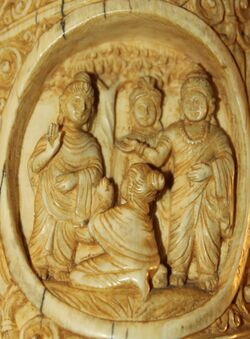Social:Northern Black Polished Ware
The Northern Black Polished Ware culture (abbreviated NBPW or NBP) is an urban Iron Age Indian culture of the Indian Subcontinent, lasting c. 700–200 BCE, succeeding the Painted Grey Ware culture and Black and red ware culture. It developed beginning around 700 BC, in the late Vedic period, and peaked from c. 500–300 BC, coinciding with the emergence of 16 great states or mahajanapadas in Northern India, and the subsequent rise of the Mauryan Empire.
Recent archaeological evidences have pushed back NBPW date to 1200 BC at Nalanda where its earliest occurrences have been recorded and carbon dated from the site of Juafardih.[1] Similarly sites at Akra and Ter Kala Dheri from Bannu have provided carbon dated of 900-790 BC and 1000-400 BC[2] and at Ayodhya of 1003 BC[3]
Overview
The diagnostic artifact and namesake of this culture is the Northern Black Polished Ware, a luxury style of burnished pottery used by elites. This period is associated with the emergence of Indian subcontinent's first large cities since the decline of the Indus Valley Civilization; this re-urbanization was accompanied by massive embankments and fortifications, significant population growth, increased social stratification, wide-ranging trade networks, specialized craft industries (e.g., carving of ivory, conch shells, and semi-precious stones), a system of weights, punch-marked coins, and writing (in the form of Brahmi and Kharosthi scripts, including inscribed stamp seals).[4]
Scholars have noted similarities between NBP and the much earlier Harappan cultures, among them the ivory dice and combs and a similar system of weights. Other similarities include the utilization of mud, baked bricks and stone in architecture, the construction of large units of public architecture, the systematic development of hydraulic features and a similar craft industry.[5] There are also, however, important differences between these two cultures; for example, rice, millet and sorghum became more important in the NBP culture.[5] The NBP culture may reflect the first state-level organization in the Indian Subcontinent.[5]
According to Geoffrey Samuel, following Tim Hopkins, the Central Gangetic Plain, which was the center of the NBP, was culturally distinct from the Painted Grey Ware culture of the Vedic Aryans of Kuru-Pancala west of it, and saw an independent development toward urbanisation and the use of iron.[6]
The end of the NBP culture around 200 BCE was marked by the replacement of the NBP ware with a different style of pottery, namely red ware decorated with stamped and incised designs.[7] However, the same cities continued to be inhabited, and the period from c. 200 BCE to c. 300 CE was still "marked by urban prosperity all over the subcontinent," corresponding to the Shunga and Satavahana Dynasties, and the Kushan Empire.[8]
Sites
Some notable NBPW sites, associated with the mahajanapadas, are as follows:[9]
- Charsada (ancient Pushkalavati) and Taxila, in Pakistan
- Delhi or ancient Indraprastha
- Hastinapura, Mathura, Kampil/Kampilya, Ahichatra, Ayodhya, Sravasti, Kausambi, Varanasi, all in Uttar Pradesh
- Vaishali, Rajgir, Pataliputra, and Champa in Bihar
- Ujjain and Vidisha in Madhya Pradesh.
Other sites where Northern Black Polished Ware have been found are Mahasthangarh, Chandraketugarh, Wari-Bateshwar, Bangarh and Mangalkot (all in Bangladesh and West Bengal, India).
A number of ancient sites where the NBPW has been found, such as Ayodhya and Sringaverapura, are mentioned in the Hindu epic, the Ramayana.[4]
References
- ↑ Tewari, Rakesh (2016). EXCAVATION AT JUAFARDIH, DISTRICT NALANDA. ARCHAEOLOGICAL SURVEY OF INDIA. pp. 6-8 Layers 13 the uppermost deposit of Period I, has provided a C14 date of 1354 BCE it may thus be seen that the C14 dates of Period I and II are consistent and justifiably indicate that the conventional date bracket for NBPW requires a fresh review at least for the sites in Magadh region..
- ↑ Ahmed, Mukhtar (2014). Ancient Pakistan - An Archaeological History: Volume V: The End of the Harappan Civilization, and the Aftermath. Amazon. pp. 127 recent excavation in the Bannu district at the sites of Akra (900-790 BC) and Ter Kala Dheri (1000-400 BC) have provided radiocarbon dates which would push the chronology of NBP at Charsadda and Taxila to as early as 900 BC.. ISBN 149970982X.
- ↑ Shanker Singh, Dr Anand (20 Nov 2017). "The Chronology of Northern Black Polished Ware : Recent Perspectives". International Journal of Scientific Research in Science, Engineering and Technology IJSRST 3: 1488-1492 The emergent picture is that the beginning of NBPW could safely be pushed to circa 700 BCE, if not earlier (Ayodhya 1003 BCE & Juafardih 1200 BCE) and therefore, the NBPW period ranges from 700 BCE to 50 BCE.. https://www.academia.edu/37100665/The_Chronology_of_Northern_Black_Polished_Ware_Recent_Perspectives.
- ↑ 4.0 4.1 J.M. Kenoyer (2006), "Cultures and Societies of the Indus Tradition. In Historical Roots" in the Making of ‘the Aryan’, R. Thapar (ed.), pp. 21–49. New Delhi, National Book Trust.
- ↑ 5.0 5.1 5.2 Shaffer, Jim. 1993, "Reurbanization: The eastern Punjab and beyond." In Urban Form and Meaning in South Asia: The Shaping of Cities from Prehistoric to Precolonial Times, ed. H. Spodek and D.M. Srinivasan.
- ↑ Samuel 2008, p. 50-51.
- ↑ Upinder Singh (2008). A History of Ancient and Early Medieval India: From the Stone Age to the 12th Century. Pearson Education India. pp. 282,286,391. ISBN 978-81-317-1677-9. https://books.google.com/books?id=Pq2iCwAAQBAJ&pg=PA389.
- ↑ Upinder Singh (2008). A History of Ancient and Early Medieval India: From the Stone Age to the 12th Century. Pearson Education India. pp. 389. ISBN 978-81-317-1677-9. https://books.google.com/books?id=Pq2iCwAAQBAJ&pg=PA389.
- ↑ A History of Ancient and Early Medieval India: From the Stone Age to the 12th Century
Sources
Samuel, Geoffrey (2010), The Origins of Yoga and Tantra: Indic Religions to the Thirteenth Century, Cambridge University Press
External links
- http://lakdiva.org/coins/ruhuna/ruhuna_elephant_srivasta_disk.html
- India Heritage - Earthenware and Pottery
 |



